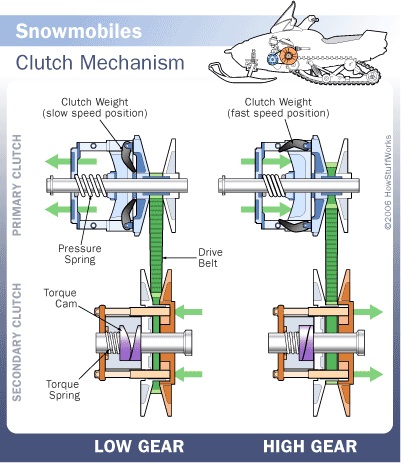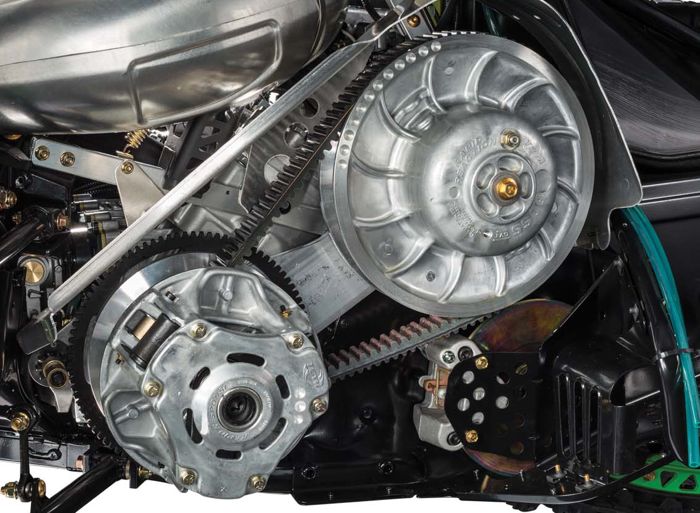 Unlike
most motorized vehicles, which have
several different set gears for various
speeds and power levels, snowmachines
operate with a specialized clutch system
that provides automatic transition
between theoretically unlimited gears
based on engine RPM. The clutch system
consists of two main parts, the primary
clutch and secondary clutch.
Unlike
most motorized vehicles, which have
several different set gears for various
speeds and power levels, snowmachines
operate with a specialized clutch system
that provides automatic transition
between theoretically unlimited gears
based on engine RPM. The clutch system
consists of two main parts, the primary
clutch and secondary clutch.Primary Clutch:
The primary clutch is connected directly to the crankshaft of the engine and consists of a stationary disc and a movable disc, with the drive belt connected to the secondary clutch located between them. The movable disc is held outward by a spring at low speed. As the engine RPM increases, the clutch weights connected to the movable disc expand outward due to centrifugal force and cause the movable disc to close in on the drive belt, thus engaging the belt and transmitting power to the secondary clutch.
Secondary Clutch:
The secondary clutch is connected to the drive shaft of the snowmachine which transmits power to the track and propels the machine. The secondary clutch operates opposite the primary clutch in that at low speeds the two halves are closer together to provide higher torque for acceleration, and at high speeds they settle outward. Tension on the belt is maintained by the position of the primary clutch.
 This
clutch system combined with the power
and responsiveness of a two stroke
engine results in one of the fastest
accelerating machines on the planet! It
can go from "low gear" to "high gear"
and vice versa easily and in an instant
and also eliminates excess weight of
having multiple gears, which is
important to operating in deep snow
conditions. The downside to this system
is that there is no way to switch gears
into reverse, but that dilemma has led
to even more ingenuity and revolutionary
engine designs. Snowmachines are now
equipped with electronic reverse systems
that actually change the direction of
engine rotation. Rather than have a
reverse gear, the whole engine just runs
backwards, reducing excess weight and
providing equal power in both the
forward and backwards directions.
This
clutch system combined with the power
and responsiveness of a two stroke
engine results in one of the fastest
accelerating machines on the planet! It
can go from "low gear" to "high gear"
and vice versa easily and in an instant
and also eliminates excess weight of
having multiple gears, which is
important to operating in deep snow
conditions. The downside to this system
is that there is no way to switch gears
into reverse, but that dilemma has led
to even more ingenuity and revolutionary
engine designs. Snowmachines are now
equipped with electronic reverse systems
that actually change the direction of
engine rotation. Rather than have a
reverse gear, the whole engine just runs
backwards, reducing excess weight and
providing equal power in both the
forward and backwards directions.